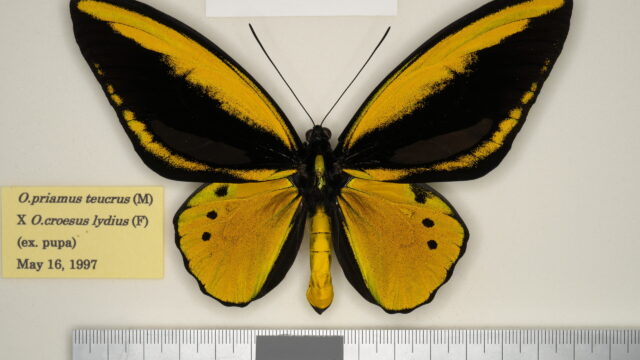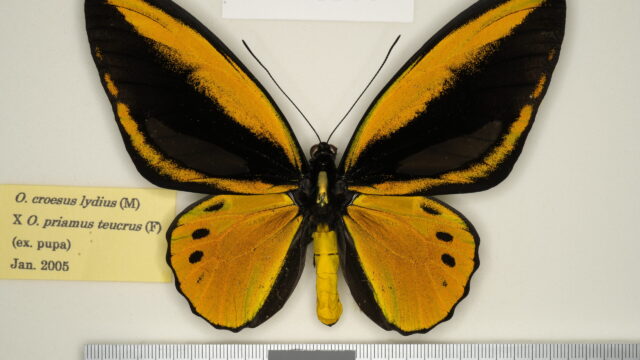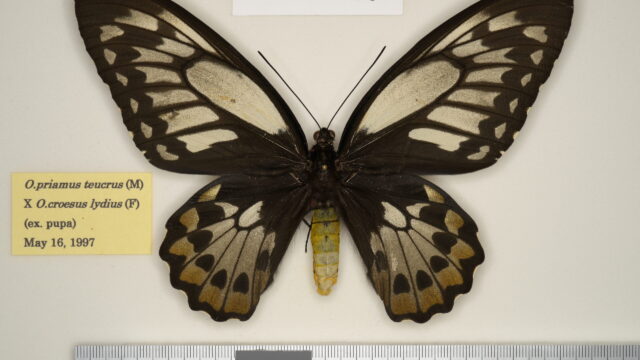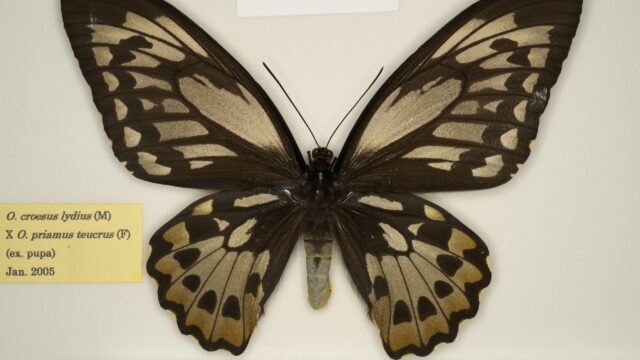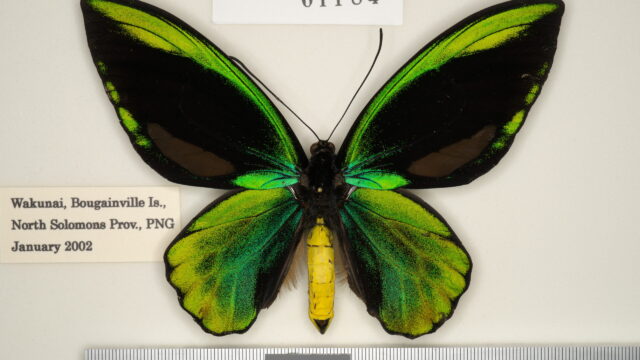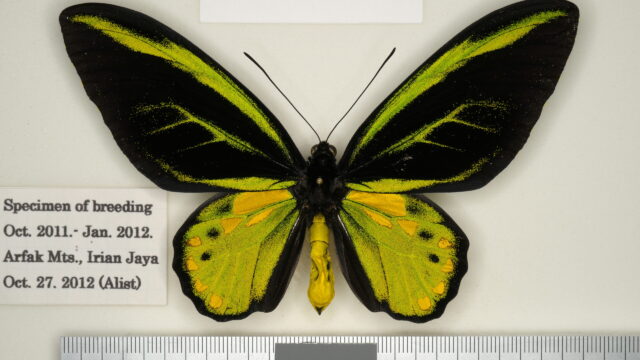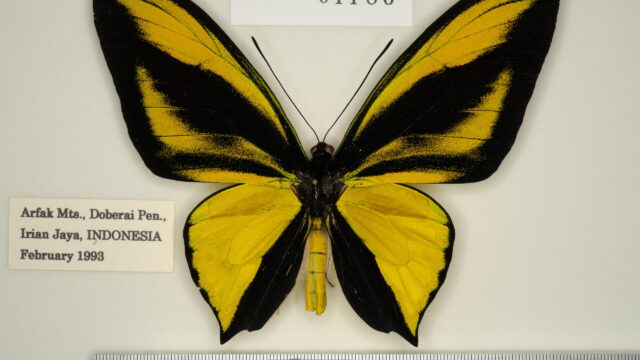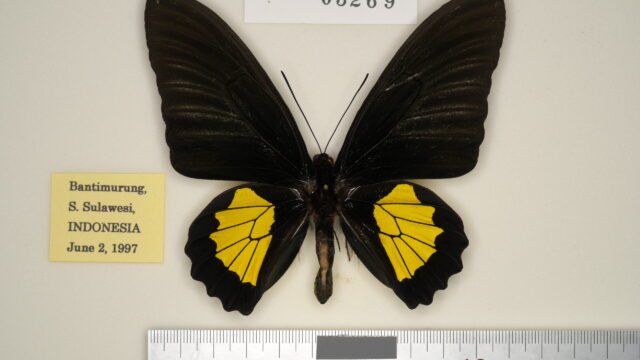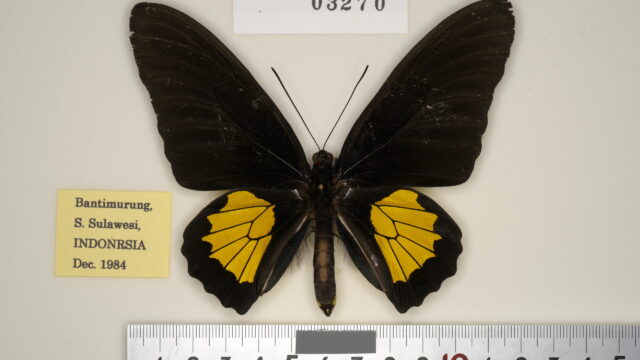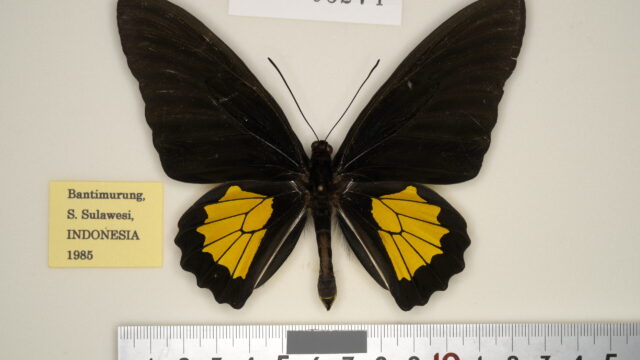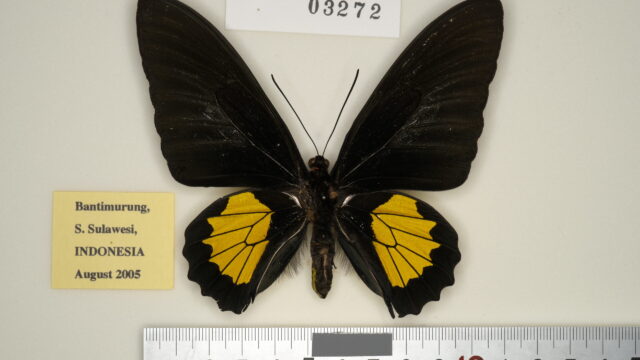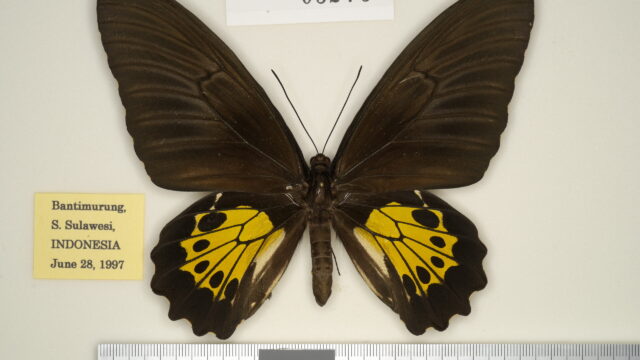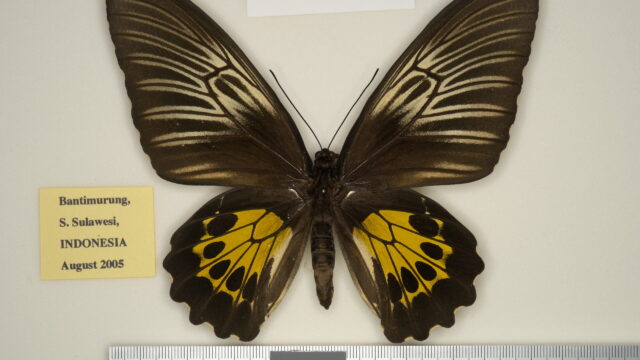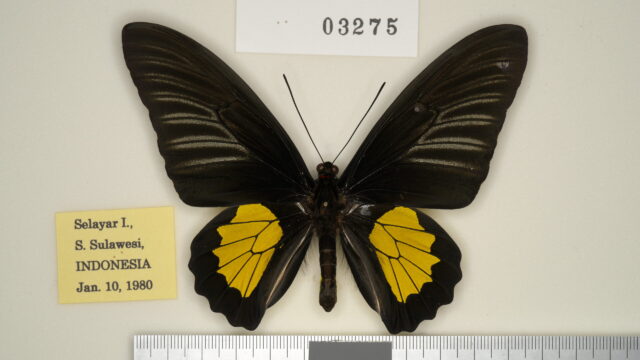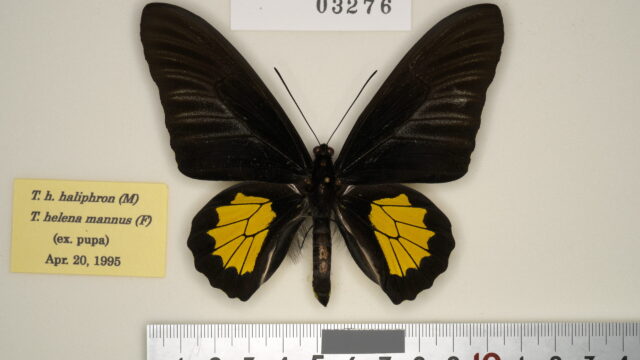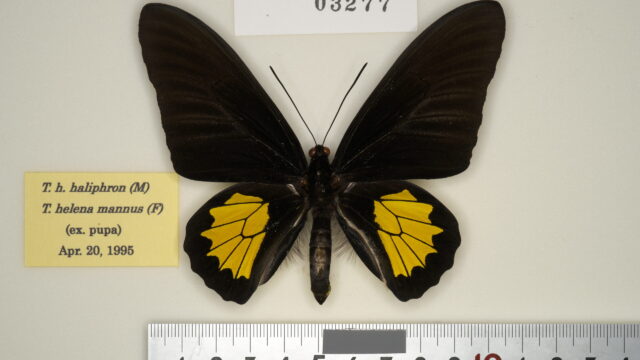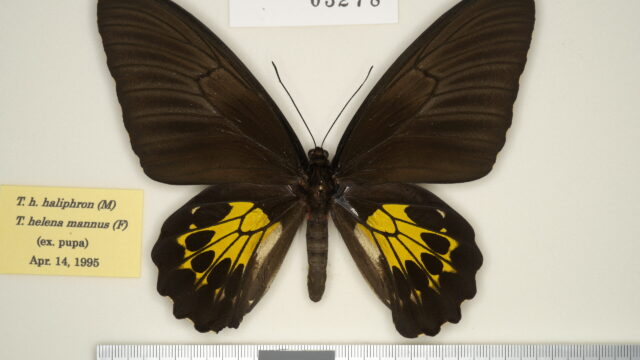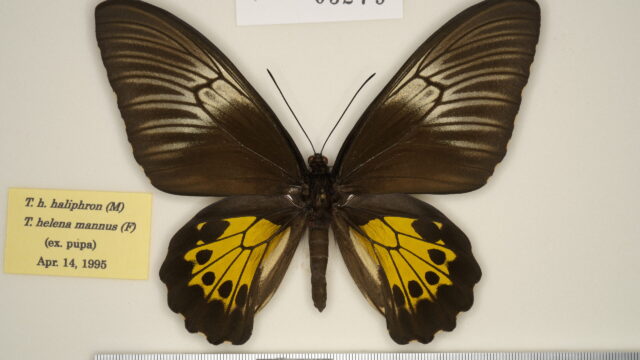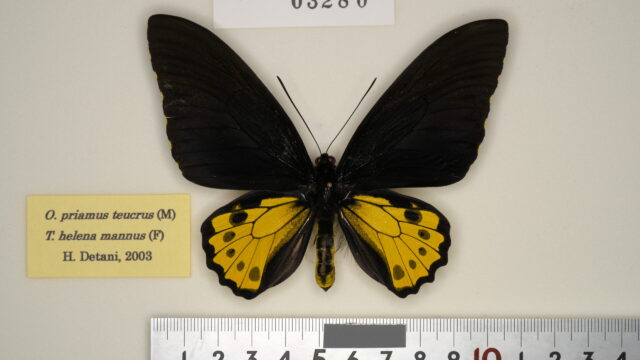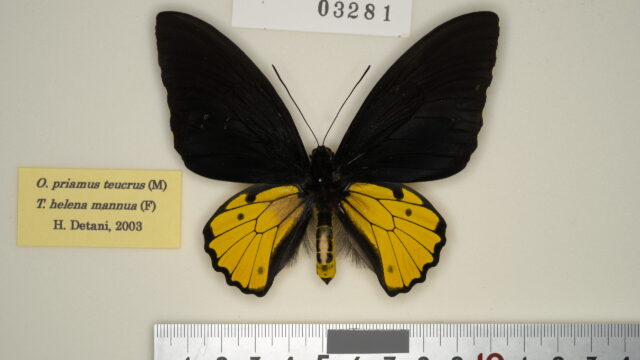Ornithoptera Natural hybrid
- O. allottei (Rothschild, 19144)) [♂] [♀: alottei Niepelt, 19162)]
(O. (A.) victoriae x O. (O.) priamus urvillianus )
- O. akakeae Kobayashi & Koiwaya, 19781) [♂] [♀: Otani & Kimura, 19983)]
(O. (O.) priamus poseidon x O. (S.) rothschildi )
- O. allottei Rothschild, 19118)
(O. (A.) victoriae x O. (O.) priamus uevillianus))
This extremely rare butterfly (♂), with its beautiful coloration and spots intermediate between those of O. vicoriae and O. priamus urvillianus, was discovered by Abbé Allotte on Bougainville Is. As the collector of this specimen, he apparently thought this butterfly was a natural hybrid, not a new species, but Rothschild8), who provides this specimen, described it as a new species in 1914. Shortly after, a pair of adults was fortunately obtained from pupae collected by Kibler on Bougainville Is., and these specimen ware reported in 1916 by Niepelt5). However, he did not actually see these specimens, but described it based on a sketch of them. The following year, 1917, an additional pair of specimens was reported by Peebles and Schmassmann7). As the number of specimens gradually increased, it can be debated whether it is natural hybrid or a new species. Rousseau-Decelle (1939)9) proposed the hybrid theory, while Zeuner (1943)11) and Munroe (1961)4) proposed the new species theory. In the 1970s, as more specimens were obtained, the species was studied in more detail, Schmid (1970) 10) and D’Abrera (1975)1) supported the new species theory, while McAlpine (1970)3) and Haugum & Low (1978) 2) proposed the hybrid theory. As Schmid (1970)10) stated, the only way to reach a true conclusion was thought artificial mating. This conclusion was finally reached by Straatman in 1986. The result was that this hot topic butterfly was a hybrid! The author (Ohya)6 ) received one sealed letter from him (Cairns in Australia) dated August 31 the same year. Inside the envelope, are four photographs (3♂♂♀) and a letter stating that an artificial mating to prove whether it was a new species or a hybrid had finally succeeded! In addition, the ♂ was golden in color and truly magnificent. Thus, the 72 years debate that had been going on since its discovery came to an end.
(Distribution)
PNG: Bougainville Is., SOLOMONS: Malaita Is., New Georgia Islands, Nggela Islands.
(Episodes of discovery and original description)
It was first described as a new species by Rothschild in 1914, based on a single ♂ collected by Father Abbé Allotte at Buin, Bougainville Island, and named after him. Later, the German collector Kibler had the great good fortune to hatch a pair from pupae there, and in 1916 Niepelt published a brief description of this specimen and its illustration in “Lepidoptera Niepeltina”. The following year, 1917, he and Schmassmann gave a detailed description of the ♀ specimen in Peebles’ own collection.
(Spotted pattern)
♂:Wing shape and FW surface similar to O. priamus urvillianus, but HW spots similar to O. victoriae. Underside spots on both FW and HW resemble those of O. priamus urvillianus, but lacking the white border on the posterior margin of the eye and red hairs on the lateral thorax.
♀: Although closely resembles to O. priamus urvillianus, but is easy to distinguish by the lack of white border margin of the eyes and of the red hairs on the lateral thorax.
2. O. akakeae Kobayashi &Koiwaya, 19781)
(O. (S.) rothschildi x O. (O.) priamus poseidon)
This butterfly was described as a new species by Kobatashi & Koiwaya3) in 1978. This type specimen was collected by Iwan Toeante in same year in Arfak Mts of Indonesia (Irian Jaya) at an altitude of 2,500 m. Later specimens of the same type were never found, leading to suspicions it was a hybrid. In 1997, though the efforts of Hiromi Detani, a resident of Bali, a natural hybrid between O. (S.) rothschildi and O. (O.) priamus poseidon was proven by artificial matings and a female was also identified. (Otani & Kimura2))
(Distribution)
INDONESIA (Arfak Mts, 2,500 m)
(Episodes of discovery and original description)
It was described by Heiichi Kobayashi and Satoshi Koiwaya based on a single ♂ collected by I. Toeante on September 19, 1977 in the Arfak Mountains at an altitude of 2500 m in a mountain range. The species name akakeae was derived from silver wattle Acacia dealbata.
(Spotted pattern)
♂: FW resembles that of O. (O.) priamus, but it is characterized by the absent of sex-brand. The spot of HW resembles that of O. (S.) rothschildi. The red hairs on lateral thorax are present.
♀: Unlike the specimen illustrated by the author (Ohya1)) in the illustrated Book “Birdwing Butterflies” (Kodansha, 1983), FW resembles O. (S.) rothschildi with some white cell-spots, and HW resembles O. (O.) priamus poseidon with developed pale-band and a white spot on the end of the cell. Abdomen is milky white, similar to that of O. priamus.
Troides Natural hybrid
- T. (T.) celebensis (Wallace, 1865) 3) [♂] [♀: unknown]
(T. (T.) haliphron haliphron x T. (T.) helena hephaestus )
- T. (T.) celebensis selayarensis Kobayashi & Koiwaya, 19812) [♂] [♀: unknown]
(T. (T.) haliphron pallens x T. (T.) oblongomaculatus thestius )
- T. (T.) prattorum ♂-f. mixtum (Joicey & Talbot, 1923)1)
(T. (T.) oblongomaculatus bouruensis x T. (T.) prattorum )
- T. celebensis (Wallace, 1865)
(T. (T.) haliphron haliphron x T. (T.) helena hephaestus)
Wallace described it as a local form of Troides helena based on a single ♂ collected at Macassar, Celebes (=Sulawesi) Island, which he himself collected, in his paper “On the phenomenon of variation and geographical distribution as illustrated by the Papilionidae of Malayan Region” in 1865. Later, it was proved to be a hybrid by artificial mating.
(Distribution)
INDONESIA: Sulawesi (=Celebes) Is. (Macassar).
(Episodes of discovery and original description)
Wallace (1865) described this species as a local form of T. helena based on a single ♂ collected at Macassar, Celebes. The name Celebensis is a reference to its habitat, Celebes.
(Spotted pattern)
Both ♂ and ♀ resemble T. helena, but HW spot is smaller and more characteristic of T. haliphron. The ♀ specimen is believed to be the first display of this hybrid.
Ssp. selayarensis Kobayashi & Koiwaya, 19811)
(T. (T.) haliphron pallens x T. (T.) oblongomaculatus thestius)
Kobayashi & Koiwaya1) compared T. celebensis 8 ♂♂, a nominal type from southern part of Sulawesi Island, with 9 ♂♂ from Selayar Island, which is located off the southern coast of Sulawesi Island and others. As a result, individuals from Selayer Island were described as a subspecies of T. celebensis in 1981, because of the smaller semitranslucent golden spots on HW and lighter coloration of the abdomen than individuals from Sulawesi Islands.
(Distribution)
Selayar Island.
